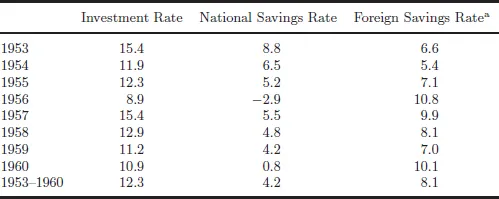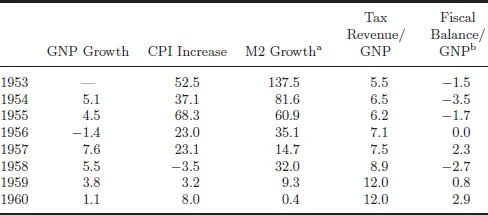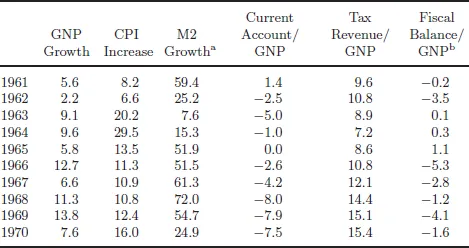![]()
Chapter 1
A Historical Overview
1.1Post-War Reconstruction and Foreign Aid (1950s)
Korea was divided into South and North following its liberation from Japanese colonial rule in 1945. As most mining and manufacturing industries were located in the northern part of the Korean Peninsula, the division of the country made the South (the Republic of Korea) an agriculture-based, resource-poor country. The Korean War, which broke out in 1950 and lasted for 3 years, caused tremendous human and physical damages. Out of population of 20 million, over a million South Korean civilians died or went missing. Almost half of the nation’s manufacturing capacity, railroad network, and electricity generation capacity were destroyed, not to mention the destruction of urban housing, roads, and other infrastructure.
The total damages were estimated higher than the GNP in 1953.1 Thus, the Korean government gave top priority to the reconstruction of infrastructure and factories destroyed during the war. Korea relied heavily on foreign assistance to rehabilitate the economy. From 1945 to 1960, the total foreign aid to Korea amounted to USD 2,935.7 million, out of which USD 2,356.3 million was contributed by the United States, accounting for 80 percent of total aid received (Table 1.1). The rest was provided by the United Nations. The foreign aid accounted, on average, for as much as 8.2 percent of GNP and financed 74.2 percent of imports during this period.
Table 1.1Foreign Aid Received, 1945–1960 (Unit: USD million)
Sources: Lee (2002, p. 341) for 1945–1952; Krueger (1979, p. 67) for 1953–1960.
Table 1.2Foreign Aid and the National Economy, 1951–1960 (Unit: percent)
Notes: a15 months from April 1954 to June 1955.
b18 months from July 1955 to December 1956.
Sources: Krueger (1979, p. 67); Bahl et al. (1986, p. 227).
The counterpart fund generated by the sales of aid goods was the important source of government revenue, accounting for 38.4 percent of total government revenue during the period of 1953–1960 (Table 1.2). It was also the major source of financing investment due to the low national savings rate. As shown in Table 1.3, the national savings rate averaged 4.2 percent during the period 1953–1960, financing only 34.1 percent of investment with the rest financed by foreign savings which averaged 8.1 percent.
The US aid was provided under the International Cooperation Agency (ICA) program and Public Law 480. The former consisted of project, non-project, and technical assistance, while the latter was to provide agricultural surplus, mainly for supporting defense expenditures. Project assistance under the ICA program was directed to support investment activities in the form of providing machines and equipment, while the non-project assistance provided raw materials and consumer goods, which were sold to the private sector to raise government revenues. Technical assistance was used for the overseas training of local officials and for foreign advisers.
Table 1.3Savings and Investment Rates, 1953–1960 (Unit: percent)
Note: aInvestment Rate–National Savings Rate.
Source: The Bank of Korea.
There was considerable policy conflict between the Korean government and the US aid agency regarding the use of aid funds. The Korean government wanted to rebuild the manufacturing industry to facilitate growth and demanded more project assistance. The US aid agency, however, insisted on providing non-project assistance to control inflation, for it was primarily concerned with stabilization rather than growth. The aid conflict was negotiated and coordinated by the Combined Economic Board (CEB),2 which was jointly chaired by the representatives of the US aid mission in Korea and the Korean government. The US aid was mostly provided in the form of non-project assistance.3 Between 1954 and 1961, for example, 74.7 percent of aid funds were allocated to non-project assistance.4 Thus, the US government, as a principal donor, had a great influence on Korea’s post-war economic policy and even intervened in the budgeting process of the Korean government.
In 1953, the government launched a 3-year comprehensive reconstruction plan (1954–1956) supported by USD 628 million of aid funds. Approximately 70 percent of the funds were allocated to imports of raw materials and consumer goods, while the rest was allocated to facility investment (Lee, 2002, p. 285). The investment was focused on repairing roads, transportation, communications and harbors, and on some key industries such as the cement and fertilizer industries.
The Korean economy made significant recovery thanks to the reconstruction plan. Most industrial production reached or surpassed pre-war levels by 1956, but inflation was a persistent problem due to monetary expansion. Despite the large inflow of foreign aid, the budgetary deficit continued due to low tax revenues until the mid-1950s, so that the government had to rely on borrowings from the central bank and issuing bonds. The banking sector was another source of monetary expansion, because commercial banks had to rely heavily on the central bank for their credit lending due to low financial savings. The result was a rapid increase in money supply accompanied by a high inflation rate. As shown in Table 1.4, the money supply (M2) and consumer price increased by 78.8 percent and 45.2 percent per year between 1953 and 1956, respectively.
The US aid mission was greatly concerned about galloping inflation and requested the Korean government to adopt a financial stabilization program, which was implemented from 1957. Government expenditures were strictly controlled, and borrowings from the central bank and the issuance of national bonds for industrial reconstruction were suspended. Tax reform was also carried out to increase revenues. The fiscal reform led to a substantial reduction in the budgetary deficit. As shown in Table 1.4, tax revenue as a share of GNP increased rapidly since 1957 so that the fiscal deficit was almost eliminated during 1957–1960, leading to a substantial reduction in money supply and price increases after 1957.
Table 1.4Major Economic Indicators, 1953–1960 (Unit: percent)
Notes: aYear-end basis; bConsolidated general government account.
Sources: National Accounts 2009, The Bank of Korea; Bahl et al. (1986, p. 57, 260).
The government adopted a multiple exchange rate system throughout the 1950s to reduce import costs while stimulating exports. Despite the high inflation rate, the government kept the official exchange rate overvalued to reduce import costs of raw materials and equipment and to acquire more dollar redemption for won advances.5 The excessive demand for imports was controlled through quantitative restrictions and high tariffs. Notwithstanding the higher exchange rate, exports did not witness a significant increase because most of them originated in primary products which were not sensitive to the exchange rate. The size of Korean exports at the time was also extremely small and amounted to a little over USD 30 million in 1960, approximately one-tenth of imports. Thus, most of the imports were financed by foreign aid.
The industrial policy was inward-looking, protecting domestic industries through high tariffs and quantitative restrictions. Prior to 1950, a uniform tariff rate of 10 percent was imposed on all imports except those financed by foreign assistance. A new law was enacted in 1950 to protect domestic industries. High tariffs were imposed on those items which were domestically produced, and duties on food grains and non-competitive equipment and raw material imports were exempted. The simple average of all tariff rates was around 40 percent.6
Imports were further controlled through a trade program that was announced semi-annually by the government, and controls were applied only to Korea’s normal trade transactions excluding aid-financed imports. Since aid-financed imports constituted more than two-thirds of total imports, overall imports were not much affected by the restrictive import policy and fluctuated depending on the foreign aid inflows.
The industrial policy was characterized by the import substitution of nondurable consumer goods such as textiles, processed foods, and chemicals. Some import substitution also took place in such intermediate goods as fertilizer, cement, and plate glass, reflecting the growing domestic demand for them. The manufacturing sector as a whole enjoyed relatively rapid growth of 12.8 percent per annum between 1953 and 1960. The GDP growth rate was, however, moderate and averaged 3.9 percent due to the sluggish growth of agriculture (2.4 percent), which was the dominant sector of the economy in the 1950s.
Although by 1960 the Korean economy fully recovered from the war, it confronted a number of macroeconomic and structural problems. Economic growth began to slow down due to the falling aid. Furthermore, the US aid policy began to shift from grants to loans from 1958, aggravating balance of payments difficulties. As the US aid declined rapidly after 1957, economic growth continued on a downturn and unemployment and inflation began to rise in the early 1960s. Political repression accompanied by economic stagnation gave rise to the student revolution in April 1960, which led to the collapse of the Rhee Syngman government.
1.2Outward-Oriented Industrial Development (1960s)
Korea’s modern economic growth started with the political change when the military government led by President Park Chung Hee came to power in 1961. At the time, Korea was one of poorest countries in the world. The country’s per capita GNP was less than USD 100, with almost half the population living below the absolute poverty line. The greatest concern of the President Park was naturally the eradication of poverty through high economic growth.
To achieve high economic growth, the government adopted the unbalanced growth strategy, setting industrialization as the primary goal of development policy and launched in 1962 its first five-year development plan (1962–1966) with the annual target growth rate of 7.1 percent. The original plan was very ambitious, placing great emphasis on the import substitution of intermediate and capital goods, which resulted in inflation and a serious foreign exchange crisis in 1963. The situation was exacerbated by aid cut of US government which was not sympathetic to the military government.
Therefore, the government had to revise the plan, shifting the development strategy from import substitution to export promotion. An outward-oriented industrialization policy was adopted to overcome small domestic market under the national slogan of “nation-building through exports.” Based on this development strategy, the government directed all the relevant policy measures toward supporting export activities.
A variety of fiscal, financial, and administrative incentives was devised to support exports, including the unitary floating exchange rate system. The most powerful incentive was the heavily subsidized export credit provided at a preferential interest rate far below the commercial lending rate. In 1964, for example, the interest rate on export credit was 8 percent, while the rate on commercial lending was 16 percent. The intensive support for exports continued in the second half of 1960s by reducing the interest rate to 6 percent and successive devaluation of exchange rate to reflect relative price changes.
These policy efforts led to the phenomenal expansion of commodity exports, which grew at an average annual rate of 40 percent between 1962 and 1971. As the balance of payments improved in the mid-1960s, the government joined the GATT in 1967 and made efforts to liberalize trade, shifting its import policy from a positive to a negative system. The efforts for import liberalization could not, however, continue further due to worsening balance of payments difficulties (Table 1.5).
It is important to note that while promoting exports, the Korean government began at the same time to encourage import substitution in heavy and chemical industries (HCIs) such as machinery, shipbuilding, electronics, steel, and petrochemicals in the second five-year plan (1967–1971). The special laws were enacted to promote them by stipulating various supports.
Table 1.5Major Economic Indicators, 1961–1970 (Unit: percent)
Notes: aYear-end basis; bConsolidated general government account.
Sources: National Accounts 2009, The Bank of Korea; Bahl et al. (1986, p. 57, 260).
The dramatic export growth coupled with support for HCIs led to investment boom generating inflationary pressure. Therefore, the government took various measures to mobilize domestic savings to meet the rapidly growing investment demand. A number of important fiscal measures were taken to increase tax revenue and to increase the efficiency of tax administration. In 1966, the Office of Tax Administration was established to improve the efficiency of tax administration, and tax reform was further undertaken in 1967 to make the tax structure more supportive of economic development. Thus, the tax revenue share of GNP increased from 9.6 percent in 1961 to 15.4 percent in 1970. Despite the swift increase in tax revenues, the public sector continued to show a fiscal deficit in the 1960s due to rapidly rising government expenditures for economic development.
An interest rate reform was also undertaken in 1965 to boost financial savings. The interest rate on 1-year savings deposits doubled from 15 percent to 30 percent, and the rate on commercial loans increased from 16 percent to 26 percent. The high interest rate policy brought about a dramatic increase in financial savings while discouraging unproductive investment, which greatly contributed to finance private investment. Thanks to rapid export growth and investment boom, the Korean economy began to take off from the early 1960s, growing at an average a...





